#intermediate bulk container
Explore tagged Tumblr posts
Text
The Benefits of Powder Handling and Tablet Handling
Delving into the World of Powder Handling
Powder handling includes dealing with the processing and movement of substances in industries such as pharmaceuticals and food production sectors to ensure seamless flow and avoid blockages or clumping issues with a focus on maintaining the integrity of powder components and preventing contamination through careful management of dust levels while achieving consistent blends and accurate powder measurements during storage in silos or hoppers, for safety reasons.
0 notes
Text
Why IBCs Are Revolutionizing Bulk Storage
When it comes to efficient bulk storage and transportation, IBC solutions are leading the charge in industries ranging from chemicals to food and beverages. But what exactly is an IBC, and why are businesses increasingly choosing them over traditional containers?

What is an IBC?
IBC, or Intermediate Bulk Container, is a reusable industrial container designed for the transport and storage of bulk liquids, powders, or granulated substances. These containers are known for their strength, reusability, and ability to hold large volumes while minimizing space.
Why Choose a Flexible Intermediate Bulk Container?
A Flexible Intermediate Bulk Container (FIBC) is a type of IBC that is lightweight, collapsible, and often made of woven polypropylene. These containers are perfect for storing dry flowable products like grains, sands, and chemicals. If you're in the UAE, sourcing from flexible intermediate bulk containers manufacturers in UAE ensures faster delivery, customized designs, and region-specific standards.
Trusted IBC Manufacturer – Quality You Can Count On
A reliable IBC manufacturer not only provides sturdy, compliant containers but also ensures sustainability through recyclable materials and efficient production practices. The best manufacturers offer solutions tailored to your industry needs—whether it’s food-grade tanks or UN-certified hazardous material containers.
Top IBC Tank Supplier in UAE
Finding a trustworthy IBC tank supplier can make all the difference in your supply chain. Leading IBC tank suppliers in UAE offer a wide range of containers, from rigid IBCs to custom FIBCs, that meet international standards and regional requirements. They understand the climatic and logistic challenges of the Gulf region and offer solutions accordingly.
Meet COBO IBC – A Game Changer in Bulk Storage
One name making waves in the IBC industry is COBO IBC. Known for its robust designs, COBO IBC products are crafted for durability, compliance, and cost-effectiveness. Whether you're looking for a lightweight container for agricultural produce or a chemical-grade tank, COBO IBC has a product that fits.
UAE – A Hub for IBC Excellence
Thanks to its strategic location and robust manufacturing sector, the UAE has become a prime destination for intermediate bulk container manufacturers. These manufacturers leverage state-of-the-art technology and global partnerships to deliver high-quality products across the Middle East and beyond.
Conclusion
Whether you're a logistics coordinator, a chemical distributor, or a food manufacturer, investing in the right IBC solution is essential for safety, efficiency, and sustainability. Partnering with top IBC tank suppliers in UAE and trusted IBC manufacturers like COBO IBC ensures your business stays ahead in the game.
#ibc#flexible intermediate bulk containers manufacturers in uae#ibc manufacturer#ibc tank supplier#intermediate bulk container#manufacturers#ibc tank supplier in uae#cobo ibc
0 notes
Text
IBC Tanks: The Ultimate Solution for Safe Liquid Storage in the UAE
Introduction
As the UAE thrives as a hub for industrial, commercial, and agricultural activities, the need for efficient liquid storage and transportation solutions has grown significantly. Intermediate Bulk Containers (IBC Tanks) have emerged as a versatile and cost-effective option for storing and transporting liquids, chemicals, and other bulk materials. In this blog, we delve into the features, benefits, and applications of IBC tanks in UAE, highlighting why they are an indispensable asset for various industries.
What are IBC Tanks?
Intermediate Bulk Containers (IBC Tanks) are durable, reusable containers designed for the storage and transport of liquids, semi-solids, and granulated substances. Made from high-density polyethylene (HDPE) or metal, these tanks are engineered to withstand heavy loads and provide excellent chemical resistance.
Features of IBC Tank
Robust Construction: Made from high-quality materials for durability and longevity.
Large Capacity: Available in capacities ranging from 500 liters to 1,000 liters, catering to various needs.
Stackable Design: Optimizes storage space and simplifies transportation.
Leak-Proof: Equipped with secure seals and valves to prevent spillage.
Easy Handling: Compatible with forklifts and pallet jacks for efficient movement.
Importance of IBC Tanks
With the UAE’s diverse industries, including oil and gas, agriculture, and food processing, IBC tanks have become essential for efficient operations. Their versatility and safety features make them ideal for storing and transporting hazardous and non-hazardous materials across the region.
Key Benefits of IBC Tank
Cost-Effective: Reduces the need for multiple smaller containers, saving time and money.
Space Optimization: Stackable design ensures efficient use of warehouse space.
Environmental Sustainability: Reusable and recyclable, reducing environmental impact.
Chemical Compatibility: Resistant to corrosion, suitable for storing a variety of substances.
Ease of Transport: Designed for seamless handling with standard equipment.
Applications of IBC Tank
Chemical Industry: Safe storage and transport of hazardous chemicals and solvents.
Food and Beverage: Hygienic storage of edible liquids like oils, syrups, and beverages.
Agriculture: Transport of water, fertilizers, and pesticides.
Construction: Storage of construction chemicals and water.
Oil and Gas: Handling lubricants, fuels, and other petroleum-based products.
Why Choose IBC Tank for UAE Industries?
The UAE’s harsh climate and stringent safety standards require reliable storage solutions. IBC tanks provide:
UV Resistance: Withstands extreme sunlight exposure.
Spillage Prevention: Reduces environmental hazards in case of accidental leaks.
Compliance: Meets international and local safety regulations for hazardous material storage.
How to Select the Right IBC Tank
When choosing an IBC tank for your business, consider the following factors:
Material: HDPE for non-corrosive substances, stainless steel for high-strength requirements.
Capacity: Choose a size that matches your storage or transport needs.
Valve Type: Ensure compatibility with the type of liquid being stored.
Regulatory Compliance: Confirm adherence to UAE standards for hazardous materials.
Accessories: Options like liners, valves, and level indicators for added convenience.
Maintenance Tips for IBC Tanks
Regular Cleaning: Prevents contamination and maintains hygiene.
Inspect Seals and Valves: Ensure leak-proof operation.
Store in Proper Conditions: Protect from extreme heat or damage.
Use for Compatible Materials: Avoid storing substances that could degrade the tank material.
Conclusion
IBC tanks are a vital asset for industries in the UAE, offering an efficient, durable, and safe solution for liquid storage and transportation. Their adaptability to various applications and compliance with safety standards make them indispensable for businesses striving for operational excellence.
If you're looking for high-quality IBC tanks tailored to your needs in the UAE, explore our wide range of products designed for reliability and performance. Contact us today to learn more about how IBC tanks can revolutionize your storage and transport processes.
#ibc tank#ibc container#ibc tank 1000 liter#ibc tank price#used ibc tank#ibc tanks for sale#intermediate bulk container#uae#dubai#abudhabi#reconditioned ibc tanks#1000 litre ibc tank#ibc container for sale#ibc tank supplier#ibc tank distributor#ibc tank wholesalers#ibc dubai#new ibc tank
0 notes
Text
Where to Find Affordable Wooden Containers
Contact USA Pallet & Warehousing, Inc. for reasonably priced wooden crates. Offering a range of choices, including basic pallets, shipping container movers, and intermediate bulk containers. We are in central Illinois, specifically Streator, Ottawa, Peoria, Pontiac, Peru, and LaSalle. Treated wood ensures quality and dependability in our pallets, including the 48x40 Block Pallet.
#warriors#clippers#suns#phoenix suns#timberwolves#victor wembanyama#clippers vs warriors#spurs#warriors game#lakers vs jazz#celtics vs nets#devin booker#nuggets vs bucks#anthony edwards#paul george#custom wood pallets#usa pallet#pallets for sale#Intermediate bulk container#shipping container movers#standard pallet weight#is pallet wood treated#pallet dimensions
0 notes
Text
Efficient Bulk Handling Solutions for Storage, Transport, and Industrial Needs
Discover how flexible intermediate bulk container bags (FIBCs) offer cost-effective and durable solutions for bulk storage, transport, and industrial applications. Learn about the benefits of FIBC bags, including customizability, strength, and eco-friendliness.
Read more - Efficient Bulk Handling Solutions for Storage, Transport, and Industrial Needs
#flexible intermediate bulk container bags#fibc flexible intermediate bulk container#flexible intermediate bulk container fibc
0 notes
Text
IBC Spill Containment Pallets: Best Practices for Use and Benefits
Ensuring spill control and safety is crucial in businesses handling huge amounts of hazardous liquids. These liquids are frequently transported and stored in intermediate bulk containers (IBCs), yet there is a chance of spilling. IBC spill containment pallets are useful in this situation. Because these pallets are designed to reduce environmental damage and increase worker safety, These pallets are crucial for following the safety standards and protecting your business.
In this blog, we will discuss the use and benefits of IBC spill containment pallets.
Understanding IBC Spill Containment Pallets
Pallets designed for IBC spill containment are made especially to store liquids and stop leaks or spills. A containment basin in robust construction collects and holds spills. This prevents them from spilling into the surrounding space. It also stops spills from reaching the floor. The robust materials used to manufacture these pallets like polyethylene, which is resistant to chemicals ensure long-term usage and durability.
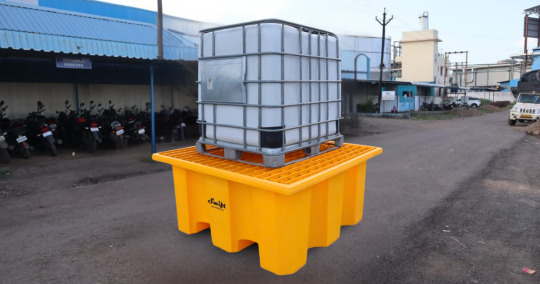
Proper Placement and Setup
Where to place: To ensure the best results with your IBC spill containment pallet, carefully place it on a flat, stable surface. Make sure the area around it is free from any obstructions and has easy handling and movement of your IBCs.
Leveling: Make sure the pallet is level to avoid spills brought on by tilting and uneven liquid distribution in the IBC.
Load Bearing Limits: Stick to the weight limits set by the pallet manufacturer. Overloading can compromise its integrity, resulting in spillage.
Handling and Transport
Proper Lifting: Forklifts or pallet jacks are suitable lifting equipment to use while moving IBCs onto and off the spill containment pallet. IBCs should not be dragged or dropped since this could harm the pallet as well as the container.
Secure Positioning: Make sure the IBC is steady and firmly positioned when it has been placed on the pallet. To prevent movement during handling or transportation, use straps or other fastening techniques as needed.
Load Management
Weight Limits: Observe the weight restrictions for the pallets as indicated by the manufacturer. Pallet overloading increases the chance of spills and can harm the structure.
Proper Loading: Position IBCs centrally on the pallets to ensure even weight distribution and stability. Avoid putting multiple IBCs on the same pallet unless it has been designed to handle such weights.
Benefits of Using IBC Spill Containment Pallets
1. Enhanced Safety
Swift’s IBC spill containment pallets are a game-changer for workplace safety. They offer a secure platform to store hazardous materials, giving you peace of mind. With their advanced secondary containment feature, any spills are contained, preventing them from spreading. This means a safer environment, less risk of accidents, and reduced exposure to dangerous chemicals.
2. Cost Savings
Spill and leak control may save you a lot of money. Spills can result in costly cleaning operations, penalties, and damage to equipment and the workplace. Investing in IBC spill containment pallets reduces the multiple costs.
3. Versatility
IBC spill containment pallets have many uses and show up in different industries such as food and drink processing, and chemical production. They can adapt to different needs, which makes them a key tool for any business working with liquids and chemicals. These pallets help keep people safe and make handling these materials more effective.
4. Easy Maintenance
These pallets are built to last and require minimal maintenance. Regular inspections and cleaning assure its longevity and efficacy, giving a long-term spill containment solution.
Conclusion
You may extend the life and efficacy of these pallets by being aware of their design and function, making sure they are positioned and set up correctly, and following safe handling and transportation procedures.
IBC spill containment pallets have many advantages, such as improved worker safety, cost savings from spill prevention, industry adaptability, and ease of maintenance. We at Swift Technoplast are dedicated to offering IBC spill containment pallets of the finest quality that meet industry standards and support the safety of your business.
Swift's products are made to provide 100% Environmentally friendly, sturdy, dependable containment solutions that guarantee worker safety. Invest in Swift Technoplast IBC spill containment pallets to enhance the safety and efficiency of your facility.
#Spill Pallets#Spill Containment Pallet#Spillage Pallet#Drum Spill Containment Pallets#ibc spill pallets#ibc spill containment pallet#ibc pallet#IBC Plastic Pallet#IBC Container Pallet#Intermediate Bulk Container Pallet#IBC Pallet Supplier#IBC Pallet Cost#oil containment pallet
0 notes
Text
Flexible Intermediate Bulk Container (FIBC): A Comprehensive Guide
Modern industrial packaging depends critically on flexible intermediate bulk containers (FIBCs), sometimes known as bulk bags, huge bags, or jumbo bags. These adaptable containers are made especially to safely and effectively store and move big goods. Applied in sectors including food, chemicals, chemicals, and building, FIBCs have transformed bulk handling operations by providing a dependable and reasonably priced packing option.
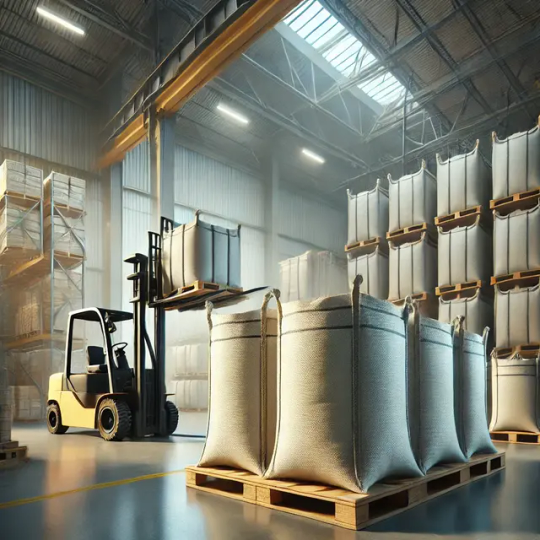
FIBCs: what are they?
Made of spun polypropylene fabric, FIBCs are big, flexible bags. Grains, sand, fertilisers, chemicals, and plastics are among the dry, flowable goods they are meant to contain and move. Depending on their construction and design, these containers can hold capacities between 500 kg and 2,000 kg or more.
Characteristics of FIBCs
Made from high-strength polypropylene, FIBCs are structural integrity-preserving yet heavy load handling tool.
FIBCs can be tailored to fit certain uses by means of size, form, and feature set including spouts, loops, and liners.
FIBCs, lightweight and reusable, cut storage and transportation expenses as compared to rigid containers.
Many FIBCs can be designed with sustainable materials and are recyclable.
FIBCs, with lifting loops, let forklifts or cranes be used for simple handling.
Various FIBC forms
FIBCs are arranged according to their application and construction:
Standard bags devoid of any static protection, type A FIBCs are used for non-flammable products.
Type B FIBCs are designed for dry, combustible materials, they provide only modest defence against static.
Perfect for combustible surroundings, Type C FIBCs are built with conductive materials and grounding systems.
Type D FIBCs are Designed for delicate materials, provide static dissipation free of grounding.
Typical uses for FIBCs
Agriculture: Agricultural transportation covers fertilisers, seeds, and grains.
Construction: Perfect for sand, gravel, and cement is construction.
Chemical Industry: Move and safely stores powdered resins and chemicals.
Food Industry: Appropriate for bulk food materials including sugar and flour.
Recycling: Managers garbage products and recyclables effectively.
Benefits of FIBCs
Fit for a range of products and sectors.
Stackable and collapsing helps to save storage space.
Reusable designs help to lower the packing waste.
Enhanced safety lowers the chance of contamination and spillage.
Considerations for FIBC Selection
Material and Construction: Choose according on weight, flowability, and sensitivity of the product.
Safety Requirements: Verify adherence to safety norms particular to your sector.
Customising: Select designs fit for your operational requirements.
Liners and Coatings: Use liners for products vulnerable to moisture or contamination.
FIBCs: Novel ideas
Anti-static compounds, UV-resistant coatings, and biodegradable choices are among recent developments in FIBC manufacture. These developments answer contemporary issues including improved safety and environmental sustainability.
Eventually
A must-have tool for bulk material handling, FIBCs provide unparalleled adaptability, efficiency, and safety. Investing in premium FIBCs allows companies to maximise their operations, lower expenses, and help to create a more sustainable future. FIBCs offer a consistent answer for your packaging needs whether you handle chemicals, building supplies, or agricultural items.
0 notes
Text
The Efficiency and Versatility of One Way Intermediate Bulk Containers
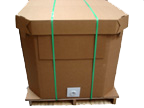
In the world of I don't know logistics and supply chain management efficiency and versatility are very important to achieve business success. That's where One Way Intermediate Bulk Container, truly come in the picture. They have emerged like a practical solution for you if you are looking forward to transport and store bulk liquids and granulated substances effectively.
What do you need to know about these containers?
Just like One Way Bag in The Box Liquid Packaging and actually large containers designed for the storage and transport of bulk liquids and solids. They are especially designed for single use applications. Unlike typical reusable containers they are actually constructed for a one time journey offering a cost effective and amazing option for you if you require transportation solutions without the need for return logistics.
Advantages of the containers
One of the best parts about the containers is that they can help you eliminate the need for return shipping and cleaning if significantly reducing operational costs. And often less expensive as compared the reusable counterparts making them a attractive option for you if you're looking for virtual reduce expenses. As one way containers are intended for single use you can also focus on shipping and storing your products without stressing about cleaning and sanitizing the containers for use. Convenience is especially beneficial for you if you have high turnover rates of seasonal production cycles.
So above all you need to know that as environmental awareness increases you are increasingly seeking sustainable solution as a business. One way these containers play a very important role in reducing waste and promoting sustainability.
0 notes
Text
Woven Polypropylene Bags Supplier in Germany
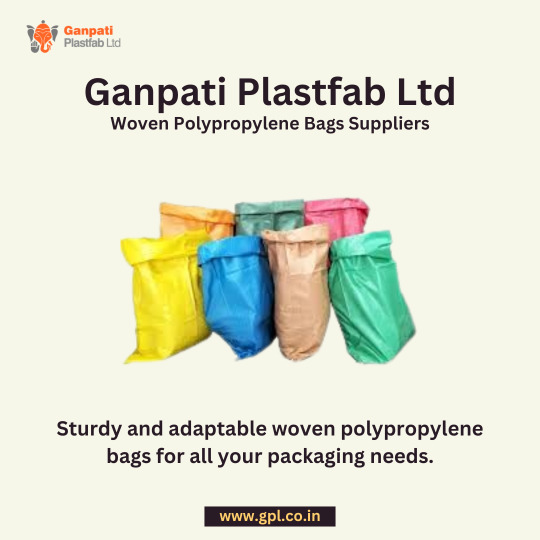
At Ganpati Plastfab Ltd, Find top-quality Polypropylene Woven Bags suppliers from trusted suppliers. Ideal for packaging and transporting a variety of goods, these durable bags ensure your products are safe and secure. Visit us: https://www.gpl.co.in/pp_plastic_woven_sacks_bags.html
#Polypropylene_Woven_Bags_suppliers#PP_Woven_Box_Bags_manufacturers#Sand Bags suppliers & Manufacturer#polypropylene bags Wholesalers#Flexible Intermediate Bulk Containers manufacturer in Germany#Sand Bag#PP Woven Bag
0 notes
Text
Matcon NPD 200L IBC: A Comprehensive Guide
Pharmaceutical and medical manufacturers and distributors face relentless pressure to up their production and delivery while maintaining and enhancing operational efficiency at the same time. To add to this pressure, they are also required to adhere to stringent quality and safety standards. These companies need to audit every aspect of their operations to avoid being fined or losing their licenses. For example, pharma companies need to keep a track of the usable life and date of tablets. Tablets must be stocked, picked and shipped in a manner that complies with regulations while still adhering to the demands of pharmaceutical customers. To ease their operations, they incorporate new technologies. They are even turning to automated warehouse systems that offer real-time data on quality, inventory management, and other critical areas, helping to improve efficiency, ensure safety, and reduce costs.
0 notes
Text
GNX® Bulk Container – SP: Reliable and Durable Chemical Transport Made Easy
When it comes to transporting hazardous or valuable chemicals, safety and reliability are non-negotiable. The GNX® Bulk Container – SP, developed by one of the leading IBC manufacturers, Elan Incorporated FZE, is designed specifically to meet these exact needs — combining sturdy construction with smart features to make chemical transport safer and more efficient.

What Makes the GNX® Bulk Container – SP Special?
At its core, the GNX® Bulk Container – SP is a tough, 1000-liter Intermediate Bulk Container (IBC) built to handle the rough conditions of long-distance chemical transportation. Its inner container is made from UV-stabilized high molecular weight high-density polyethylene (HM-HDPE), which means it resists degradation from sunlight and chemical exposure. The container measures 1200 x 1000 x 1155 mm — a perfect size for stacking and handling.
As a flexible intermediate bulk containers manufacturer, Elan offers versatile filling and discharge options. The standard filling opening (DN 150) and discharge valve (50mm butterfly valve) come ready for everyday use, with optional larger sizes available to meet specific requirements.
Some standout features include:
All-Steel Pallet: The container sits on a fully steel pallet that’s built to withstand heavy loads and rough handling, protecting the contents and maintaining stability.
Strong Structural Design: The container features a 3-ribbed top profile and anti-vibration braces that connect the vertical supports to the top ring, giving it excellent durability when stacked and transported.
Rust Protection: It comes with a plastic drip pan, which stops rust from forming and helps the container last longer.
Ease of Handling: With a 4-way composite pallet design, it’s easy to move with pallet trucks, making warehouse and transport handling smooth.
Safety Compliance: Bolted ground contact points ensure the container is properly earthed, meeting strict environmental and safety standards.
Thoughtful Engineering for Practical Use
Beyond its strength, the GNX® Bulk Container – SP incorporates clever design tweaks like scientifically aligned verticals to reduce bulging, a press-fit clinch sleeve for secure assembly, and an enlarged access area for easier valve replacement. These improvements make maintenance and reuse straightforward, giving businesses more value from their investment.
As a trusted IBC manufacturer and IBC tank supplier, Elan has engineered this container to meet the demanding needs of hazardous chemical transport, maintaining safety and compliance without compromising on durability.
Trusted Worldwide
The GNX® Bulk Container is widely used not only in established markets like Europe and America but also in emerging regions such as the Middle East, Asia, and Africa. Its design excels in tough environments, handling the bumps and jolts of road and sea transport while keeping the chemicals secure.
Being recognized as a best IBC tank supplier in UAE, Elan’s products have gained strong market acceptance for their superior quality and innovative features.
Why Choose GNX® Bulk Container – SP?
Meets certifications for transporting hazardous goods safely
Robust materials that stand up to UV rays and chemical exposure
Options for filling and discharge tailored to your needs
Designed for easy handling, filling, and maintenance
Environmentally friendly with recyclable pallet components
If you’re searching for reliable intermediate bulk container manufacturers or a dependable IBC tank supplier, the GNX® Bulk Container – SP from Elan offers a combination of durability, versatility, and safety that makes it an excellent choice.
Contact Elan Incorporated FZE
In summary, the GNX® Bulk Container – SP is a thoughtfully engineered, durable, and versatile container designed to make chemical transport safer and more efficient. Elan, as a premier IBC manufacturer and flexible intermediate bulk containers manufacturer, delivers a product that guarantees safety, quality, and long-term value for your business.
#leading ibc manufacturer#best ibc tank supplier in uae#flexible intermediate bulk containers manufacturers#ibc manufacturer#ibc tank supplier#intermediate bulk container manufacturers
0 notes
Text
Kambara
Here I go again with croc stuff. Back to dealing with stuff thats longer established, let me tell you about Kambara, the oldest named mekosuchine and a genus that surprised me with the bulk of information behind it.
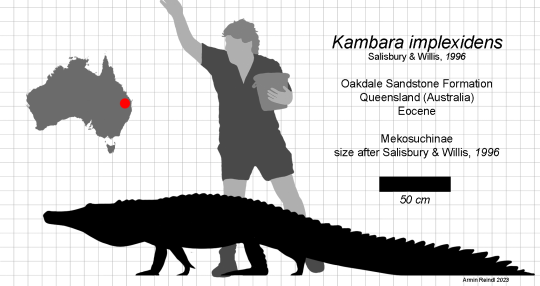
Kambara (which simply translates to "crocodile") is a genus of early mekosuchine that as of July 2023 contains four species, all from the Eocene of Queensland.
The first of these are Kambara murgonensis (Crocodile from Murgon) and Kambara implexidens (Interlocking Teeth Crocodile), both of which found at the same locality in Murgon, Queensland. The bones of both were in fact so intermingled that it was initially assumed that they represented a single species with highly variable anatomy, before the second species was recognized 3 years later.
There are a couple of differences between, but two are easiest to point out. For one, although being in the same size range (3-3.5 meters as adults), Kambara implexidens was a little more gracile. Furthermore, and the defining difference between them, K. implexidens (left) had interlocking teeth like a crocodile (bottom left), but K. murgonensis (right) had an overbite like an alligator (bottom right).



The next species named after these two was Kambara molnari (Molnar's Crocodile), but it's only known from much more limited material, the holotype being a lower jaw. Still some interesting information from this can be gathered. Which is that K. molnari seemingly represents an intermediate between interlocking dentition and an overbite. K. molnari wasn't found near Murgon, but in a different basin in Queensland, in the lower layers of the Rundle Formation.
Also from the Rundle Formation we have the most recently named and geologically youngest species, Kambara taraina (Crocodile Crocodile). Yeah the name is a bit redundant, but the logic of basing the species name on the Darumbal dialect as a proxy for language of the Bailai People is a nice one. Anyhow, K. taraina is a return to form as it is also known from good material like the first two, stemming from yet another large fossil bed possibly representing a mass death site. It had interlocking dentition like K. implexidens, BUT, unlike the oldest two species it did not coexist with the other Rundle Kambara. Instead, K. taraina came after K. molnari had presumably gone extinct.
Shown below the paratype of K. taraina, the holotype of K. implexidens and the holotype of K. molnari.
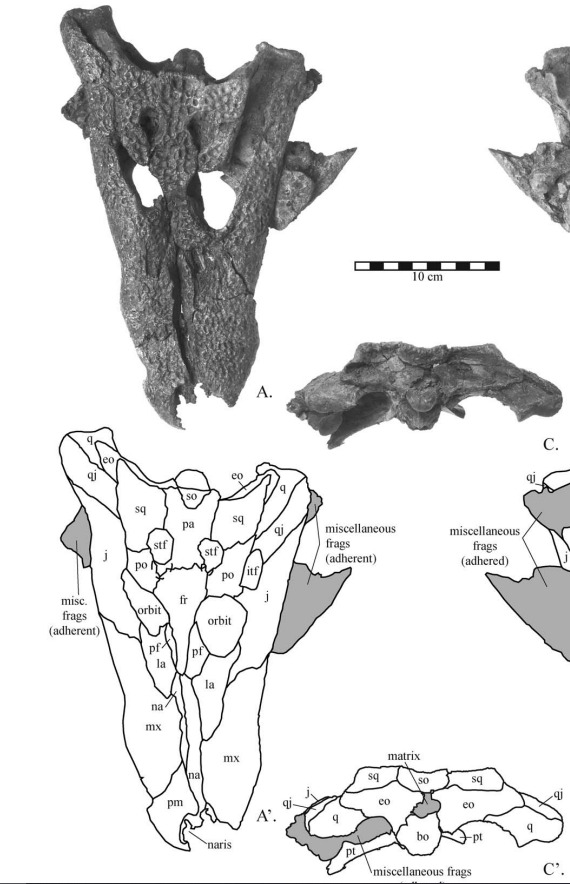
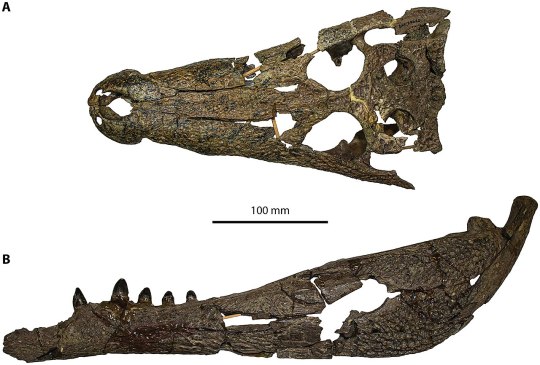
I won't get into phylogeny too much other than that its usually thought off as one of the earliest branching mekosuchines, but details vary. Lee and Yates found that Australosuchus may be more basal, while Ristevski et al. recover Kalthifrons as the earliest branch, in both cases Kambara is only the second branching. There is one slightly odd alternative. Rio and Mannion do find it as the oldest branching mekosuchine....but also regard neither Quinkana nor Australosuchus as members of the clade...and further seemingly find "Asiatosuchus" germanicus to nest within Kambara? And then there's 2 out of the 8 trees by Ristevski, which show Kambara as a close relative to modern Crocodylids. But neither of those results match the current concensus and Rio and Mannion in general has a lot I disagree with.
Much more interesting is the postcrania and the implications for the lifestyle of Kambara. Now while we have a lot of bones from the rest of the body, given they were found in literal bonebeds, we don't know much about it. Crocodile fossils that aren't skulls are rarely described in detail. But there's still some information out there. Important here are Stein et al. 2012 and Buchanan's PhD thesis (which included the description of K. taraina, the one part that was formally published). Both looked at the postcrania and found that there are some differences to modern crocs. To keep things brief, while the anatomy is not nearly as derived as in a fully terrestrial croc, it does seem to suggest that Kambara would have had an easier time performing the crocodilian highwalk (shown below).

Again, this does not necessarily mean it lived on land, if anything the circumstances of the animals death seems to imply the opposite, but its still interesting. Buchanan suggests that this could have been used to walk through shallow water or bottom walking, and Stein et al. do point out that some adaptations of the limbs could also be advantages while swimming. The most important part to suggest that Kambara still lived in the water is the skull tho (well and it being found in freshwater habitats). The skull looks still remarkably like that of your generalist croc, somewhat flattened, nostrils on top, raised eyes, all that kind of stuff. So it presumably hunted like a modern croc and lived like a modern croc.
The exact lifestyle remains obscure tho. Again, generalist seems like the best supported hypothesis, but we don't know what kind of difference interlocking teeth and the overbite make. Theres some speculation of course. Mook for example proposed that an overbite functions like carnassial teeth in mammals, slicing and breaking, whereas interlocking dentition is better for gripping. While the difference in robustness between K. murgonensis and K. implexidens isn't that great, it could be suggested that the more robust species sliced and broke larger prey while the more gracile one dealt with slippery fish or struggling animals. Muscle attachments are also important, and those seem to show that the most recent species, Kambara taraina with interlocking teeth, had the greatest bite force and thus may have fed on larger prey than all its predecessors. But again, a lot of this requires further looking into.
We do have one singular piece of evidence for diet. The shell of a turtle from the Rundle Formation clearly bearing the tooth marks of Kambara. The bite marks show that the turtle was bitten multiple times, likely in an attempt to position it better in the mouth to bring it into position with the crushing back teeth or to swallow. Fun fact, this behavior is referred to as "juggling". But as you can see from the first figure, the Kambara in question was a bit cocky and picked a turtle way too large, eventually giving up. Sadly the turtle was very injured, and tho the wounds healed slightly, it eventually died from an infection.


For the last section I briefly want to cover some last notes on Kambara murgonensis and Kambara implexidens, more specifically their coexistence. Now I covered the potential difference in hunting and prey preference already, but theres some other stuff to consider. For example, although found in the same locality, it is possible that this cohabitation was not the status quo. Given it is a mass death site at a locality that is known to have undergone wet and dry seasons, it is not unreasonable to assume that these animals died during a drought (another point against terrestrial life too, as they could have just left otherwise). Now even today crocs will gather in large groups in such situations, trying to make the most of dwindling water sources. This could mean that both species typically inhabited different biomes and only came together because they were forced to. The same might have also happend to Kambara taraina, causing increased aggression and explaining the many injured specimens found. Anyhow, it is also a possibility that they weren't divided by species, but by size, age and maturity. Buchanan points out that there are different habitat preferences between nesting females and juveniles, subadults and adult males in modern saltwater crocodiles. Big males prefer open water, nesting females areas with denser vegetation and subadults should avoid both as they threaten hatchlings and could be eaten by cannibalistic males. So that could also factor into the distribution of Kambara. And notably, it is pointed out that the Murgon site preserves both hachlings and egg shales, but seems to lack animals of intermediate size, which could suggest it was a nesting site. Below a picture of an American Alligator and an American crocodile, simply because they remind me of Kambara and are an example of crocodilians that overlap in range, yet aren't super different like lets say Muggers and Gharials.

Alas Kambara suffers the mekosuchine curse, which is to say even with overwhelming material not much is actually published. Two bonebeds with all sorts of material, yet only 5 papers to its name, generally just accounting for the type description of each species + the humerus paper. A lot of the info presented is actually from L.A. Buchanan's PhD thesis, which did include the description of Kambara taraina. However, since the completion of the thesis in 2008, only the description of the species was actually published. Entire chapters dealing with pathologies, postcrania and potential ecological inferrence are all are only present through the thesis, which has thankfully been uploaded in 2017.
Nevertheless, its a fascinating animal and I hope I made some people curious. Wikipedia page: Kambara - Wikipedia
#croc#crocodile#mekosuchinae#crocodilia#eocene#palaeoblr#prehistory#paleontology#long post#australia#skeletal#pseudosuchia#kambara#kambara implexidens#kambara murgonensis#kambara molnari#kambara taraina
75 notes
·
View notes
Text
IBC Cap Market Size, Share, Trends, Growth and Competitive Analysis
"IBC Cap Market – Industry Trends and Forecast to 2028
Global IBC Cap Market, By Product Type (Flange, Plugs, Vent-in Plug, Vent-out Plug and Screw closure), Type (Plastic IBC, Metal IBC and Composite IBCs), Material Type (Plastics, Metal, Aluminium and Steel), End Use (Chemicals & Fertilizers, Petroleum & Lubricants, Paints, Inks & Dyes, Food & Beverage, Agriculture, Building & Construction, Healthcare & Pharmaceuticals and Mining), Application (Food And Drinks, Chemical Industry, Oil and Agriculture), Country (U.S., Canada, Mexico, Brazil, Argentina, Rest of South America, Germany, France, Italy, U.K., Belgium, Spain, Russia, Turkey, Netherlands, Switzerland, Rest of Europe, Japan, China, India, South Korea, Australia, Singapore, Malaysia, Thailand, Indonesia, Philippines, Rest of Asia-Pacific, U.A.E, Saudi Arabia, Egypt, South Africa, Israel, Rest of Middle East and Africa) Industry Trends and Forecast to 2028
Access Full 350 Pages PDF Report @
The global IBC cap market is expected to witness significant growth over the forecast period due to the increasing demand for intermediate bulk containers (IBCs) in various industries such as chemicals, food and beverages, pharmaceuticals, and others. The IBC caps play a crucial role in ensuring the safe storage and transportation of liquid products. The market growth is also being driven by technological advancements in IBC cap designs, such as tamper-evident seals and spouts for easy dispensing. Additionally, the growing focus on sustainability and recyclability of packaging materials is further boosting the adoption of IBC caps made from eco-friendly materials.
**Segments**
- Based on material type, the IBC cap market can be segmented into plastic, metal, and others. Plastic caps are widely used due to their lightweight nature and cost-effectiveness. - By cap type, the market can be categorized into screw caps, snap-on caps, and flip-top caps. Screw caps are preferred for their secure sealing properties. - On the basis of end-user industry, the market can be divided into chemicals, food and beverages, pharmaceuticals, and others. The chemicals segment is anticipated to hold a significant market share due to the widespread use of IBCs for storing chemical products.
**Market Players**
- TPS Industrial Srl - Schuetz GmbH & Co. KGaA - Mauser Packaging Solutions - Time Technoplast Ltd - Berry Global Inc. - THIELMANN UCON AG - Precision IBC, Inc. - Peninsula Packaging LLC
These market players are actively involved in strategic initiatives such as product launches, partnerships, and acquisitions to strengthen their market presence and expand their product offerings. The competitive landscape of the IBC cap market is characterized by intense competition, prompting companies to focus on innovation and quality to gain a competitive edge.
The Asia-Pacific region is expected to witness substantial growth in the IBC cap market, driven by the rapid industrialization and the increasing adoption of IBCsThe Asia-Pacific region represents a significant growth opportunity for the global IBC cap market due to several key factors. With rapid industrialization and the expanding manufacturing sector in countries like China, India, and Southeast Asia, there is a growing demand for efficient storage and transportation solutions, including IBCs and their associated caps. The increased focus on chemical production, food processing, and pharmaceutical manufacturing in the region further fuels the need for reliable packaging solutions like IBC caps. As these industries continue to grow, the adoption of IBC caps is expected to rise, driving market expansion in the Asia-Pacific region.
Moreover, the emphasis on enhancing safety standards and ensuring product integrity is a crucial factor contributing to the growth of the IBC cap market in Asia-Pacific. Regulations regarding the safe handling and transportation of hazardous chemicals and pharmaceuticals necessitate the use of high-quality caps that can effectively seal and protect the contents of IBCs. As companies in the region strive to comply with stringent regulatory requirements, the demand for advanced and secure IBC caps is projected to increase significantly.
Additionally, the shift towards sustainability and eco-friendly practices is another trend shaping the IBC cap market in Asia-Pacific. With growing environmental concerns and increasing awareness about plastic pollution, there is a rising preference for IBC caps made from recyclable and biodegradable materials. Market players in the region are focusing on developing sustainable packaging solutions to meet the evolving consumer demands and align with global sustainability goals. This shift towards eco-friendly IBC caps not only addresses environmental concerns but also presents market players with opportunities to differentiate their offerings and attract environmentally conscious customers.
Furthermore, the competitive landscape of the IBC cap market in Asia-Pacific is characterized by the presence of both local manufacturers and international players. Local companies often have a strong understanding of regional market dynamics and customer preferences, giving them a competitive advantage in catering to specific industry needs. On the other hand, multinational companies bring technological expertise and a wide product portfolio, which can appeal to a broader customer base seeking innovative and**Global IBC Cap Market, By Product Type**
- Flange - Plugs - Vent-in Plug - Vent-out Plug - Screw closure
**Type**
- Plastic IBC - Metal IBC - Composite IBCs
**Material Type**
- Plastics - Metal - Aluminium - Steel
**End Use**
- Chemicals & Fertilizers - Petroleum & Lubricants - Paints, Inks & Dyes - Food & Beverage - Agriculture - Building & Construction - Healthcare & Pharmaceuticals - Mining
**Application**
- Food And Drinks - Chemical Industry - Oil and Agriculture
The Global IBC Cap market is experiencing significant growth due to the rising demand for intermediate bulk containers across various industries. Plastic caps are increasingly preferred for their lightweight and cost-effective nature, driving market growth within the material type segment. Screw caps, known for their secure sealing properties, dominate the cap type category. The chemicals segment is anticipated to hold a substantial market share among end-user industries, attributed to the widespread use of IBCs for chemical storage. The market players in the industry are focusing on strategic initiatives like product launches and partnerships to enhance their market presence and offerings. The competitive landscape is intense, spurring companies to innovate and prioritize quality for a competitive advantage.
In Asia-Pacific, the IBC cap market is poised for robust growth fueled by rapid industrialization and the expanding manufacturing sector, particularly in countries like China,
Countries Studied:
North America (Argentina, Brazil, Canada, Chile, Colombia, Mexico, Peru, United States, Rest of Americas)
Europe (Austria, Belgium, Denmark, Finland, France, Germany, Italy, Netherlands, Norway, Poland, Russia, Spain, Sweden, Switzerland, United Kingdom, Rest of Europe)
Middle-East and Africa (Egypt, Israel, Qatar, Saudi Arabia, South Africa, United Arab Emirates, Rest of MEA)
Asia-Pacific (Australia, Bangladesh, China, India, Indonesia, Japan, Malaysia, Philippines, Singapore, South Korea, Sri Lanka, Thailand, Taiwan, Rest of Asia-Pacific)
Key Coverage in the IBC Cap Market Report:
Detailed analysis of IBC Cap Market by a thorough assessment of the technology, product type, application, and other key segments of the report
Qualitative and quantitative analysis of the market along with CAGR calculation for the forecast period
Investigative study of the market dynamics including drivers, opportunities, restraints, and limitations that can influence the market growth
Comprehensive analysis of the regions of the IBC Cap industry and their futuristic growth outlook
Competitive landscape benchmarking with key coverage of company profiles, product portfolio, and business expansion strategies
TABLE OF CONTENTS
Part 01: Executive Summary
Part 02: Scope of the Report
Part 03: Research Methodology
Part 04: Market Landscape
Part 05: Pipeline Analysis
Part 06: Market Sizing
Part 07: Five Forces Analysis
Part 08: Market Segmentation
Part 09: Customer Landscape
Part 10: Regional Landscape
Part 11: Decision Framework
Part 12: Drivers and Challenges
Part 13: Market Trends
Part 14: Vendor Landscape
Part 15: Vendor Analysis
Part 16: Appendix
Browse Trending Reports:
Calcium Glycinate Market Retinal Biologics Market Facial Fat Transfer Market Angio Suites Diagnostic Imaging Market Adoption Of Benelux Power Tools Market De Quervains Tenosynovitis Treatment Market Biodetectors And Accessories Market Colposcope Market Sports Medicine Market Automotive Adhesives Market Infrared Imaging Market Vapour Deposition Market Professional Diagnostics Market Ct Scanner Market Programmable Application Specific Integrated Circuit Asic Market Hospital Operating Room Or Products And Solutions Market Castor Oil Market Zika Virus Infection Drug Market Toluene Diisocynate Market Antibiotic Resistance Market
About Data Bridge Market Research:
Data Bridge set forth itself as an unconventional and neoteric Market research and consulting firm with unparalleled level of resilience and integrated approaches. We are determined to unearth the best market opportunities and foster efficient information for your business to thrive in the market. Data Bridge endeavors to provide appropriate solutions to the complex business challenges and initiates an effortless decision-making process.
Contact Us:
Data Bridge Market Research
US: +1 614 591 3140
UK: +44 845 154 9652
APAC : +653 1251 975
Email: [email protected]"

2 notes
·
View notes
Text
oh wooden four-way pallet.... oh intermediate bulk container.... oh hydraulic pallet jack...
2 notes
·
View notes